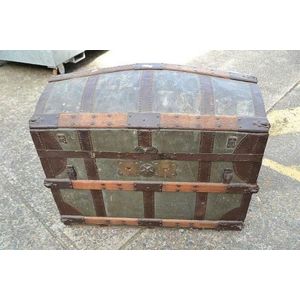Victorian Silver Tea Set with Engraved Inscription
English hallmarked sterling silver Victorian three piece tea set comprising a hinged lid teapot, sugar & creamer, having a half fluted square form body with a timber handle & finial, engraved 'Presented to the Revd. F.H. & Mrs Waller on leaving Humshaugh by the Parishioners & friends November 1899'. Set in a red cloth lined fitted mahogany box. Teapot; Sheffield, 1896, maker Martin, hall & Co sugar & creamer; Sheffield, 1897, maker Martin, hall & Co. Condition excellent to good, minor wear to the bases. Height of teapot 16 cm. Weight including handle & finial 979g
You must be a subscriber, and be logged in to view price and dealer details.
Subscribe Now to view actual auction price for this item
When you subscribe, you have the option of setting the currency in which to display prices to $Au, $US, $NZ or Stg.
This item has been sold, and the description, image and price are for reference purposes only.
- Victorian Period - The Victorian period of furniture and decorative arts design covers the reign of Queen Victoria from 1837 to 1901. There was not one dominant style of furniture in the Victorian period. Designers used and modified many historical styles such as Gothic, Tudor, Elizabethan, English Rococo, Neoclassical and others, although use of some styles, such as English Rococo and Gothic tended to dominate the furniture manufacture of the period.
The Victorian period was preceded by the Regency and William IV periods, and followed by the Edwardian period, named for Edward VII (1841 ? 1910) who was King of the United Kingdom and the British Dominions and Emperor of India for the brief period from 1901 until his death in 1910. - Hallmarks - A mark stamped on articles of precious metals in Britain, since the 14th century, certifying their purity. It derives its name from the Guild Hall of the Goldsmiths' Company, who recieved its Charter in 1327 giving it the power to assay (test the purity) and mark articles of gold and silver.
The hallmark will consist of several marks, including the:
- silver standard mark, indicating the purity of the metal. Sterling silver is .925 pure silver.
- the city mark indicating the city in which it was assayed eg London, Birmingham, York etc.
- the date mark, usually a letter of the alphabet in a particular font and case,
- a duty mark, indicating whether duty had been paid to the crown, and only in use from 1784 to 1890
The piece may include an additional mark, the maker's mark, although not forming part of the hallmark, will be located in the vicinity of the hallmarks.
Sometimes silver plated items will bear faux hallmarks, often confusing those not familiar with silver markings. - Engraving - The method of decorating or creating inscriptions on silver and other metal objects by marking the surface with a sharp instrument such as a diamond point or rotating cutting wheel.
- Mahogany - Mahogany is a dense, close grained red-coloured timber from the West Indies and Central America. It was first imported into Europe in the the early 18th century and its use continued through the 19th century. It was popular for furniture making because of its strength, the wide boards available, the distinctive grain on some boards, termed flame mahogany and the rich warm colour of the timber when it was polished.. The "flame" was produced where a limb grew out from the trunk of the tree, and this timber was usually sliced into veneers for feature panels on doors, backs and cornices.
Some terms used to describe mahogany relate to the country from which it originally came, such as "Cuban" mahogany, "Honduras" mahogany etc. However unless the wood has been tested the names assigned are more a selling feature, rather than a true indication of the timber's origin. - Sterling Silver - Sterling silver is a mixture of 92.5% pure silver and 7.5% of another metal, usually copper. Fine silver is 99.9% pure silver, and is relatively soft and the addition of the very small amount of copper gives the metal enough strength and hardness to be worked into jewellery, decorative and household objects.
- Finial - An architectural decoration, found on the upper parts of of an object. On furniture they are usually found on pediments, canopies and shelf supports. On smaller ceramic or silver items, such as spoons, they may decorate the top of the item itself, or the lid or cover where they provide a useful handle for removal.
Finials have a variety of shapes and forms. They may be urn-shaped, baluster shaped round or spiral, but usually taper into an upper point. Many real life shapes may also be used as finials, such as pineapples, berries, pinecones, buds, lotus and acorns. Sometimes animals such as a lion are depicted, or fish and dolphins.
This item has been included into following indexes:
- Martin Hall & Co. (England) - silver, maker or retailer 170
- tea sets/services
Visually similar items

Antique domed top Saratoga trunk with decorative metal work, approx 70 cm high, 88 cm long, 56 cm deep
Sold by
in
for
You can display prices in $Au, $US, $NZ or Stg.

Antique French bronze hall lantern, or turned bronze & glass. 74 cm high
Sold by
in
for
You can display prices in $Au, $US, $NZ or Stg.

Georg Thams for Vejen Polstermøbelfabrik Denmark., pair of black leather winged lounge chairs, 1960's-1970's, chromed flat steel base, loose cushions upholstered in black leather
Sold by
in
for
You can display prices in $Au, $US, $NZ or Stg.

Antique Swiss carved wood figural music box
Sold by
in
for
You can display prices in $Au, $US, $NZ or Stg.
